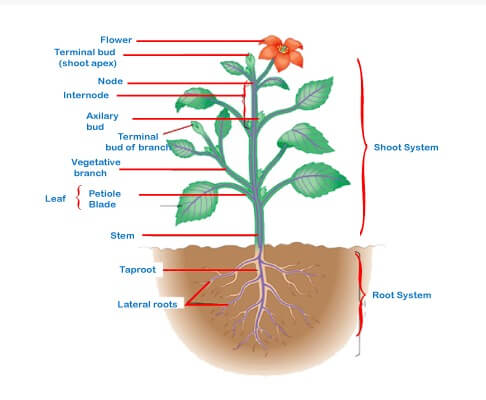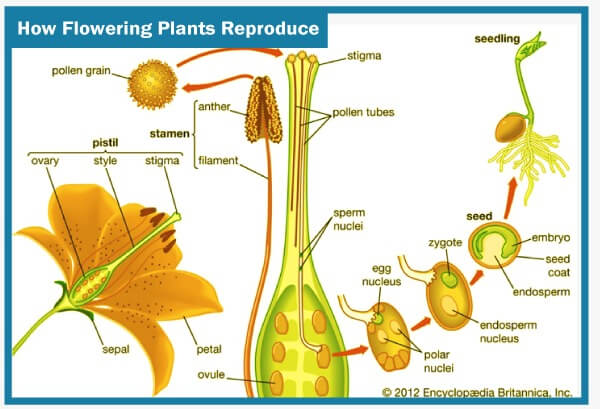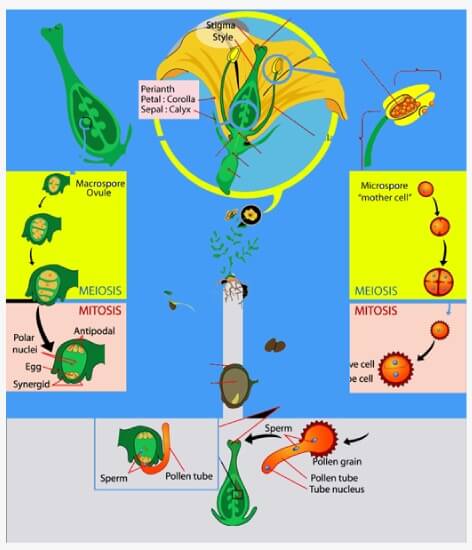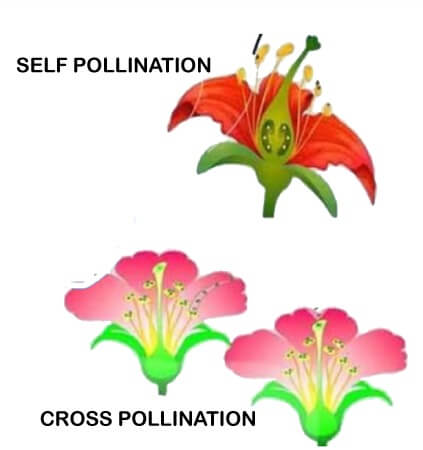PANGIOSPERMS PLANTS
What are angiosperm plants?
The angiosperm plants are the flowering plants which are also known as Magnoliophyta or Angiospermae. The word angiosperm is derived from the Greek language in which angeion means "vessel" and sperma means "seed." They are one of the most diverse and most significant categories of plants found on the planet. As per the available data, about 453 families with 260,000 living species are included in angiosperms. Almost 80% of all green plants lie under the category of angiosperm plants. They are found in nearly every habitat except in uppermost mountain ranges, Polar Regions, and deepest blue oceans.
Characteristics of Angiosperm Plants
Some of the essential characteristics of angiosperm plants are as under:
- The angiosperm plants can use a more species-specific breeding system compare to other plants. It is because of the unique reproductive organs in the flowers of these plants.
- The stamen of these plants holds pollen. This quality allows these plants to prevent self-fertilization when they increase the odds of fertilizing another flower of the same plant or another plant. With the help of this process, angiosperms generate a higher genetic variability in their species.
- The male and female gametophytes of these plants are smaller than the gametophytes of seed-bearing plants known as gymnosperms.
- These plants have a closed carpel that are surrounded the ovules. The carpels are produced into a fruit along with the other accessory parts. The fruit is an essential organ of a plant that helps in seed dispersal.
- These plants develop endosperm. It is a nutritive tissue that helps in the formation of the embryo or for the seedling.
Anatomical Structures
The anatomical structure of angiosperm plants are as under:
- Root Systems: The roots work as the supplier of water and minerals to every part of the plant after absorbing them from the soil. These nutrients are transported via the stem. The root systems are divided into two categories: primary root system and tertiary root system. The primary root systems have the taproots, which grow vertically in the downward direction. After it, taproots originate various smaller lateral roots that can grow diagonally or horizontally. The primary roots are different from tertiary roots because they are very short spanned roots.
- Stem Systems: The stem is the central part of the plant, which works as a pillar to hold all the other parts of the plant. It is an aerial axis in nature. The stem is also responsible for transporting the water and minerals from roots to the leaves, flowers, and other parts. For this purpose, the stem is directly connected to the root system, so the flows of nutrients remain continuous. This flow takes place through a transition region called the hypocotyl. The leaves are connected to the stem at nodes, and the area between two successive nodes is known as internodes. There are two forms of branching in these plants, which include axillary and dichotomous. The axillary branching is further divided into two modes: monopodial and sympodial.
- Leaves: The leaves are another essential part of the angiosperm plants. The structure of a leaf is made up of leaf base, petiole, stipules, and blade, also called the lamina. Each turn of the leaf base contains a pair of stipules. The petiole connects the blade with the leaf base. These blades support the process of food formation called photosynthesis in the plants. It is due to this process; the blades appear flattened and green in most plants. Some leaves do not have petiole while in some others stipules are absent. It implies that the basic structure of leaves varies from plant to plant, which depends on their functionality. The patterns of leaves in these plants can be alternate, opposite, paired, and whorled.

Reproduction in Angiosperm Plants
- These plants are seed-producing and can make double fertilization with the help of their male and female gametophytes.
- The main phase in the life of these plants is the adult phase when they start reproduction. This phase is known as the sporophyte.
- These plants are heterosporous, which helps them in the generation of microspores and megaspores.
- The microspores are responsible for forming the pollen grains in which the male gametophytes are present. Each pollen grain has a couple of cells. Among these two cells, one originates the pollen tube while the other is the generative cell further divided into two sperms. On the other hand, the megaspores produce the ovules that contain the female gametophytes. The ovule contains the megasporangium, which is secured by the ovary wall.
- The process of meiosis occurs in this megasporangium. Under this process, one large and three small megaspores are produced.
- From these megaspores, only the large one survives and transforms into the embryo sac. Then this megaspore is divided into thrice, which led to the formation of the eight-cell stage.
- After it, the migration process of cells begins in which four out of eight cells move to the direction of the embryo sac pole. Only two of these four cells reach the equator and forms a 2n polar nucleus.
- A mature embryo contains a single egg sac, three antipodal cells, a couple of nuclei (located at its center), and two helping cells called synergids.
- When the pollen grains reach the stigma, the pollen tube gets extended from the cell. Hence, two sperms cells are put down in the embryo sac.
- The process of double fertilization begins when the sperm cells are dropped on the embryo sac. It led to the combination of an egg and a single sperm which helps in the development of the future embryo. On the other side, the fusion of the second sperm with the second polar nuclei led to the formation of the endosperm. The food in the plant is reserved in this endosperm tissue.
- Additionally, the zygote helps in the development of the monocots and eudicots (dicots). They are the two types of angiosperms that cause the different numbers of embryonic leaves in plants. On the surface of the embryo, lipids, proteins, and carbohydrates are stored.
- Cotyledons supply broken-down food reserves to the developing embryo.
- The angiosperms are classified into three species which include:
- Hermaphroditic: They have the pistils and stamens on the same flower.
- Monoecious: They have pistils and stamen on the different flowers of the same plant.
- Dioecious: They have both pistils and stamen on different flowers of different plants.

Angiosperm Pollination
In the process of reproduction of these plants, pollination plays a very vital role. The formation of pollens takes place in the male sex organs of the plant called stamens. These pollens are then transferred to the female sex organ of the plant called a pistil. The process of transportation of pollen from stamen to pistil is known as pollination. The pollination in the plants is done by some agents who include wind, insects, invertebrates, and other mammals. There are two forms of pollination that include self-pollination and cross-pollination.


Types of Angiosperm
We can categories the angiosperm plants into two types:
1. Monocotyledons: These are the head of grass-like flowering plants, which are commonly known as monocots. The unique characteristic of these plants is that their seeds have only one embryonic leaf or cotyledon.
- Examples: There are about 60,000 species of monocotyledons. The most prominent family of this group is orchids which have more than 20,000 species. Orchids are an essential member of this category as per the economic point of view. Most of the agricultural plants or crops belong to this category. They include grains, footage grasses, sugarcane, and bamboos. Various other economic plants are palms, bananas, etc. Other than this, there are some monocots that are also cultivated for their blooms.
- Fruits: Banana, pineapple, dates, coconut, etc.
- Vegetables: Garlic, asparagus, gingers turmeric, cardamom, asparagus, rushes, onion, sedges,
- Grains: Corn, wheat, rice, oats, barley, etc.
- Trees: Palm trees, pine trees, etc.
- Flowers: Tulips, daffodils, lily, crocus, iris, orchids, cannas, bluebells, amaryllis,
- Some Unusual Monocot Plants: Grass, bamboo, sugar cane, etc.
2. Dicotyledons: These are the groups of flowering plants which are commonly known as dicots. The unique characteristic of these plants which makes them different from monocots is that their seeds have two embryonic leaf or cotyledons.
- Examples: There are about 200,000 species of dicots. Various dicot plants are listed below:
- Fruits: Apples, grapes, mango, strawberries, pear, watermelon, pomegranate, etc.
- Vegetables: Carrot, soybeans, radish, tomato, eggplants, bell peppers, Brussel sprouts, squash, etc.
- Tree: Almond tree, oak tree, dogwood, quacking aspen, chestnut tree, etc.
- Flower: Hollyhock, foxglove, sunflower, begonia, crane's bill, snapdragon, roses, marigold, etc.
- Some Unusual Angiosperm Plants: White baneberry, rafflesia arnoldii, pelican flower, baobab tree, butterwort, etc.
DIFFERENCE BETWEEN MONOCOTS AND DICOTS
The following comparison chart explains the main differences between monocots and dicots:
| S. No. |
Monocots |
Dicots |
| 1. |
Their embryos have a single cotyledon. |
Their embryos have double cotyledon. |
| 2. |
They have a parallel venation in leaves. |
They have a network or reticulate venation in leaves. |
| 3. |
The stems of these plants have scattered vascular bundles. |
The stem of these plants has ring patterned vascular bundles. Many of them have secondary growth. |
| 4. |
They have a fibrous root system. |
They have a taproot system. |
| 5. |
Monocots contain monosulcate pollen. |
Dicots contain trisulcate pollen. |
| 6. |
The roots and stems of these plants can't increase their diameter and possess a cambium. |
The roots and stems of these plants can increase their diameter and possess a cambium. |
| 7. |
The count of parts of these flowers is three or its multiples. Hence, they are trimerous. |
The count of parts of these flowers is four or five or their multiples. |
| 8. |
Examples of monocotyledon plants are palms, orchids, lilies, and grasses. |
Examples of dicotyledon plants are oaks, beans, sunflowers, cauliflower, apples, and buttercups. |
Ecological Importance of Angiosperm Plants
The ecological importance of the angiosperm plants is described below:
- These plants are a vital component of the terrestrial environment and provide food for animals and human beings.
- The metabolic and nutritionist needs of the plants are fulfilled by carbohydrates. The carbohydrate also provides the cellular structure to the plants. Angiosperms transfer their energy into many heterotopic organisms.
- They are also an essential component of the food chain. First, the plants store the solar energy in their tissues to convert it into chemical energy. Then this energy is transferred to herbivores (those who eat plants), and from them, it transfers to carnivores (those who eat other living organisms).
- In the forests, a single angiosperm feeds thousands of animals. It implies the importance of angiosperms for the ecological web and food chain.
- A vast number of insects and invertebrates consume the vegetative parts of these plants.
- The flowers, fruits, and seeds of these plants provide energy to many animals and human beings.
- The angiosperms also provide pollen to bees.
- These plants also produce various secondary compounds that include glycosides, oils, and alkaloids. These toxic compounds save the plants from foreign invasion of herbivores.
Economic Importance of Angiosperm Plants
Other than the ecological importance, the angiosperms have high economic importance also. It can be understood from the points given below:
- The plants are highly useful in pharmaceuticals. Almost all medicines are derived or extracted either directly from these plants or synthesized, and then significant components are obtained from these plants. These medicines include antibiotics, vitamins, aspirin, quinine, and narcotics.
- The extracted medicines from these plants are used as follows:
- Quinine: To treat malaria.
- Vincristine: To treat leukemia.
- Curare: To relax muscles during open-heart surgeries.
- Diosgenin: Used as a precursor in oral contraceptives.
- In the research, it is found that certain angiosperms are highly effective in the treatment of cancer, leukemia, and several heart problems. It is due to their toxicity.
- The versatility of these plants supplies a considerable amount of food and oxygen to the environment, which are the two core elements of life.
CO-EVOLUTION OF ANGIOSPERMS
This is a process of adaptation between two species over time. It helps them in influencing each other. Various types of co-evolution are as follows:
- Predator and Prey: The flowering plants are also the prey for the animals called predators. This shows the predator and prey relation between them. The plants don't want to sacrifice their leaves, stems, roots, and flowers for seed dispersal. To keep themselves safe from the predators such as rabbits or others, the plants develop various mechanisms. They include strong scents, poisons, and thorns. For example, the vital essence of marigolds saves them from rabbits and deer. Their bitter taste also protects them from being prey. The most effective way used by the plants for their protection is thorns and spines. Roses and cacti are the best examples of them. Another example is stinging nettles which have spiky hairs to keep the predators away.
- Parasite and Host: Sometimes, angiosperm plants work as a host to parasites. Almost all of the parasitic plants are angiosperms. Some of the common parasitic plants are epiphytes and vines. Mistletoe is a popular plant of such a category that grows on the top of trees and shrubs. The parasite connects itself with the vascular system of the host to get the nutrients. This continuous loss of nutrients and water damages the tree's health. The parasites don't kill a tree but make it weaker. Another example of the parasitic plant is the dodder covering the host tree with a slight woody plant. One more example of the parasitic plant is the vine which can quickly take over an entire garden. The vines insert their roots into the stems of the host.
- Competition: All the angiosperm plants are part of the competition. As we can see, the giant trees spread their branches to soak up more sunlight. This blocks the rays from reaching the lower plants. Some of them also try to crowd each other to grab all the available space. The angiosperms have to attract the pollinators like bees and birds for the process of pollination. For this purpose, these plants develop fantastic fragrances, shapes, and colors. For their survival, the flowering plants not only fight with each other but also with other plants.
- Mutualism: Mutualism is the relationship between many insects and plants. For example, in South America, some acacia plants and ants have a mutual relationship. The trees produce nectar for ants, which is the food for them, and in return, the ants protect these plants from insects and predators such as bugs. Other than this, the plants also provide a safe home to the ants in their hollow thorns. As both ants and trees are getting benefits from each other, the relationship shows a case of co-evolution.
|




 For Videos Join Our Youtube Channel: Join Now
For Videos Join Our Youtube Channel: Join Now









